With the pandemic becoming less of a threat to daily life, the conversation about a return to office needs to happen now. Executives and team leaders have their own thoughts on whether it’s the right option. However, there seems to be less focus on what the average employee thinks about a return to the office.
Exactly how important is WFH and return to office for employees?
Working from Home Is a Priority for Employees
It might not be a major surprise to find out that many team members prefer to remain working from home. It’s clear that the autonomy and flexibility of working remotely have proven to be a reality that workers want, whether a pandemic is occurring or not.
Four in 10 Americans who are currently working from home one day or more a week have indicated they would look for new employment if their business required a full return to business premises. This comes straight from a WFH survey run jointly by the University of Chicago, ITAM, and Stanford University.
However, this isn’t the only statistic that speaks to how important flexible work is for employees. Almost half of the workers who are currently remote would choose to leave their job rather than return to the office. That’s a huge number of people. And it affects businesses of all kinds, so it doesn’t matter what industry you are in. Your workers want to remain working from home.
Of those who would quit in this situation, 6.4% indicate they would do so even if they do not have another job lined up. While this number is smaller, that doesn’t make it any less crucial to be aware of. Having a method for people to work from home will prevent turnover and attrition. It’s something worth considering for team managers and executives.
Employers right now are in a tough spot when it comes to return to office strategies. Even the best solution may leave you losing workers if full-time office appearances are what you are hoping for. A compromise might be the best you can hope for when it comes to keeping your employees happy.
One of the top priorities for workers today is family. This is a big part of the reason that many want to remain working from home. A return to office means a commute and hours away from the things that matter most. Not needing to spend time on the road and in the office gives extra flexibility and more time to spend with loved ones.
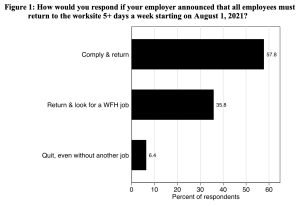
Study shows that most employees, especially those living with children, would look favorably on a new job that offers the same pay and the option to work from home 2 or 3 days a week:
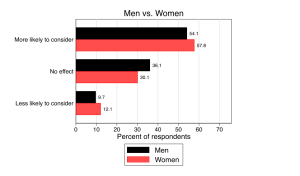
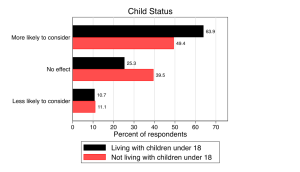
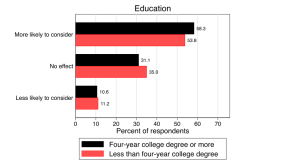
Companies are not oblivious to these preferences. The Economist reported that the proportion of tech jobs mentioning remote working jumped to 77% in August:
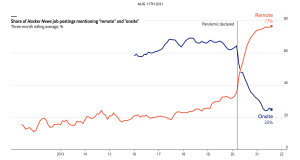
The chief economist at Indeed sees the shift towards remote working as “permanent”. As companies are embracing a remote or hybrid work model, leaders need to adopt new ways for keeping their teams connected and maintaining culture. Pre-pandemic routines need to be replaced with the ones that ensure trust and equity in a new environment.
Executive vs. Employee Perspective on Return to Office
There is a disconnect between executives who want a return to office and employees who desire the exact opposite. In April 2021, Apple Chief Executive Tim Cook sent out an employee message going over the hybrid back-to-work plan. President Joe Biden also sent out a message to federal workers letting them know it’s time to come back to the office.
However, employees aren’t feeling this same excitement and desire to be back in the office. A survey of 10,000 global workers by the Future Forum shows a huge disconnect between executives and employees in terms of the return to office. While 75% of executives want to work from an office at least three days a week, only 33% of employees feel the same way.
There are also other differences in thought. About 44% of executives who were fully remote throughout the pandemic want to come back to the office, while only 17% of employees who did the same thing are interested in a return to office. Tons of other research exists that shows workers are happy being remote and don’t want to go back to the way things were.
Many executives have a better setup at work. Most have an office with a door. Few are dealing with child care problems like employees are. The reality is that even with hybrid work, executives aren’t listening to the employees who want more flexibility. A bias can start between those in the office and those at home.
Is Hybrid Work a Middle Ground for Return to Office?
When executives want a return to office and employees want to remain remote, it might seem there’s no way to make everyone happy. However, hybrid work may be the solution that works for both workers and leadership. It provides many of the benefits of both in office and at home work without a lot of penalties.
If you aren’t familiar with hybrid work, it is a truly flexible work arrangement. It offers a blend of remote, in-office, and on-the-go workers. Employees have a greater deal of autonomy around where they work based on what makes them the most productive. It’s an approach that revolves around unique people and the workplace that works for them.
With hybrid work, employees work where they like, which creates better job satisfaction and productivity. Employees have the flexibility to work from home or any other location that might be comfortable for them. Some might work primarily from home while others mainly work in the office and others could work at both several days a week.
Understanding the benefits and disadvantages of hybrid work can give you a better if of whether it might work for you and your team.
Pros of Hybrid Work
As with any decision, there are pros and cons to hybrid work. With both on-site and remote workers, hybrid models can work well when implemented right. The benefits below may give you an idea of what to expect.
Higher Engagement and Happiness
Workers will choose the work arrangement that makes them happy, efficient, and comfortable. Having a choice between working from home or at the office is empowering for many. Hybrid workers are free to work in the office on days they want to and stay at home when that is preferred.
Increased Efficiency
Hybrid work means fewer people are in the office every day. It’s less crowded and can be made to be more efficient for those who come sin. The additional space can be used for one-to-one meetings, quiet spaces, and other relaxation areas. With the right space management, it never feels too empty or crowded.
Fewer Operational Costs
Costs are reduced with a hybrid model since fewer computers, printers, desks, and office supplies are needed. Utility costs may also go down. Downsizing on real estate can bring in thousands of dollars of savings for companies who go hybrid.
Cons of Hybrid Work
Knowing the drawbacks is also essential when making a change. Below are a few of the disadvantages associated with hybrid work models.
Less Collaboration
Spontaneous chat is harder to incorporate in virtual settings. It can also be challenging for virtual workers to talk to those in the office and vice versa. Putting good communication tools into place can help with this problem.
Challenges Around Scheduling
When there’s flexibility, it can be harder to make schedules. Creating guidelines around schedules can be useful here. When a clear schedule is in place, along with good communication, people are empowered to work and collaborate.
When it comes down to it, there aren’t many cons to having workers remain out of office. And the challenges associated with hybrid work can be mitigated with technology and proper planning. It could be the perfect solution to keep both leadership and workers happy.
FEATURED TEAMRADERIE EXPERIENCE
Moments of connection and engagement are important for remote teams. Teamraderie virtual team experiences provide an effective way to inspire and connect remote teams. One of the most popular experiences is A Legendary NASCAR Coach’s Secrets of Elite Teams.

A legendary Nascar coach, who revolutionized the way NASCAR pit crews operated, joins your team live and helps your team see teamwork through the lens of professional pit crews. Your team will perform its own competitive, virtual pit stop (with a car we send you!).


